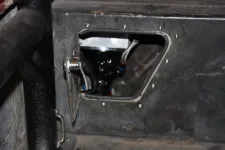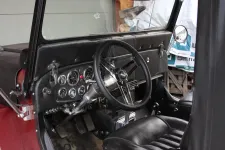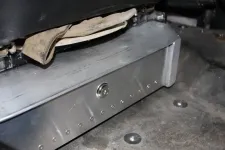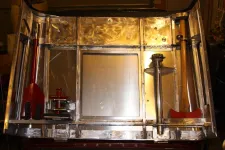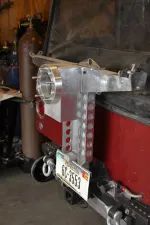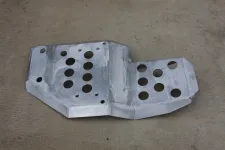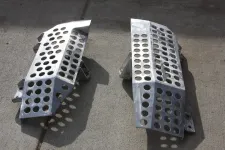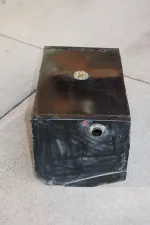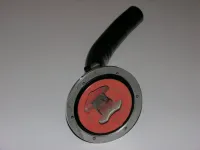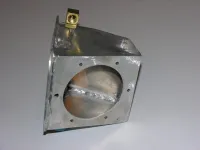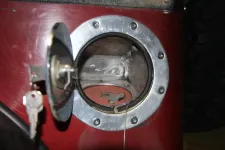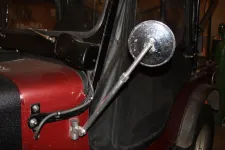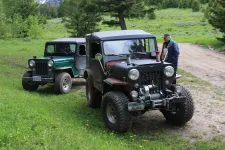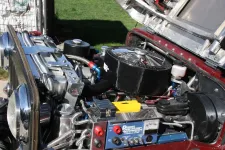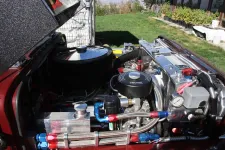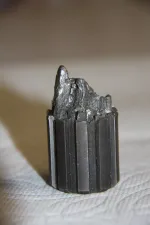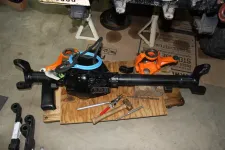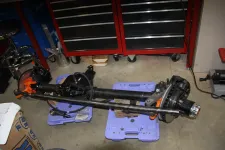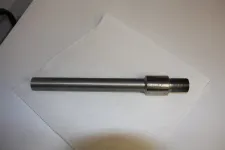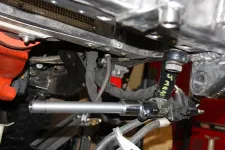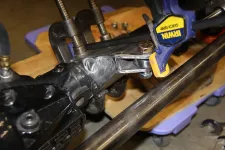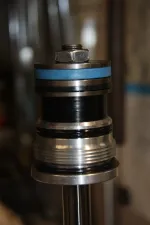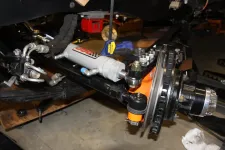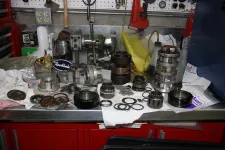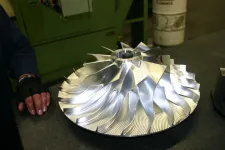Build Thread 1955 CJ 3B 53 year odyssey
duffer
Active Jeeper
- Posts
- 482
- Media
- 9
- Thanks
- 49
- Location
- Bozeman, MT
- Vehicle(s)
- 1955 CJ3B: Dart/AFR aluminum 441 sbc, AGE M22W trans, "super" D18 w/ TeraLows & Warn OD, FF44 ARB/Dutchman Rear, D44 front-ARB/Reid/Dutchman, 4 wheel discs, York OBA, PP welder, 8274 w/ 9.5 XP motor/Zeon 12 contactor, glass/aluminum body, 33-12.5's;
1968 CJ5: all stock (V6/T86/D18/D27/D44) except 4bbl & headers and rear aux tank, HD rear 44 housing, Warn OD, Belleview winch, Whitco top (New Blue)
1968 CJ5: mostly stock (V6/T90/D18/D27/D44), unknown make 3" lift springs, 11" Bendix brakes, Warn OD, unknown electric winch, Kayline tire/jerry can carrier, Bestop Super Top (Old Blue)
1947 2A and 49 3A that may or may not get built, and several FC/wagon derelicts
Where to start? I purchased this 3B in 1972 from a welding/machine shop where it had been their plow Jeep and local delivery vehicle. It was completely stock except for the shop built snowplow with a Meyers lift. As part of that plow mounting, there was a 6x10x1/2" thick angle iron plug welded over the original bumper, 1/4" fish plates welded to the outside of the horizontal portions of the front frame rails extending past the front spring frame hangers, boxed frame horns, and "sleeves" welded to the front spring plates through which the blade supports ran back to 1/2" plates bolted to the rear fish plates. Clear as mud? It actually was well engineered plow lift and allowed for full spring articulation, granted with the heavy duty flat fender springs, that was barely perceptible. It sported the factory canvas half cab and still had the factory NDT for a spare tire. Accessorys included the placebo Harrison heater, manual right side wiper, and passenger seat. It had 26k on the odometer. I only found two photos of it as received.

And it sort of managed to make an appearance in this scene.

The tub had typical rust: the hat channels were gone as was most of the tool box enclosure and the tub mounts. I used it in that state for about a year and a half until I managed to burn the F head 2-3 exhaust valves trying to pull a tiny U-Haul trailer 650 miles. Enter version 2.0. At that point it was pushed off that proverbial modification cliff and a 1962 327 sbc found its way under that high hood, the rest of it remaining stock except for the original tires and wheels from my 68 CJ5 ,a patched up Whitco top from the same, and a swing-out rear tire/jerry can/ski rack carrier I built. The sbc was the 11:1 CR version with solid lifers, big heads, 302 Winters intake, Holley 650 cfm carb, and Hooker 9810 headers. As would be expected that left something to be desired in the rocks but it was an order of magnitude better than the F head. It was a pretty wild ride on the pavement with that engine the 5.38 gears. Only one photo survived of that version from 1974.

Alas, that 327 scummed to a crack in the rear side of the No 5 cylinder about a year and a half after the install, not an uncommon occurrence with those first year 4" blocks bored 0.030 over. At that point, the fall off that proverbial modification cliff much accelerated, perhaps not yet at terminal velocity but close. I did a frame off which became a little protracted with a job/state change in the middle of it. Changes with Ver 3.0 included a boxed frame, Con-Fer rear fuel tank, battery relocated beneath bed, new cross member under the radiator, 16:1 Saginaw steering box from a C3 Corvette, full float 19 spline Powr-Lok rear Dana 44 , 11" Bendix brakes, Muncie M20 Transmission , Warn Overdrive , 1970 350 LT1 engine (yep, slow learner), Chevy truck vertical style radiator, fiberglass tub and fenders, and a number of other changes. Initially it still sported the stock springs but those were swapped out for Rancho 2 1/2" lift springs almost as soon as those hit the market-remember this is still 1970's. I probably should have installed a NT Dana 30 at that point but those were still relatively new and expensive. The D25 persisted.
A few photos of Ver 3.0




The glass tub was actually a 12'/foot plastic car kit. Separate pieces for the shell, floor and firewall and the only one I could find was for a 2A/3A so the cowl and firewall required that 4.5" extension and while I was assembling it, I made an inch and a half larger indent for distributor clearance.. I fabricated a subframe under the seat area to which the seat support frame bolted to and it provided sill support for the "sliders". The exhaust was also hung from that framework.

My original intent was to use an aftermarket steel hood, no doubt an early MD Juan product. It was painted with the rest of it, including the original grill, with catalyzed acrylic enamel but you can guess where that went. VERY poor fit and I couldn't use it.
This was the B at that point:

The LT1 was more than a wild ride with the remaining 5.38 gears and as one would expect, it didn't care too much about crawling over rock gardens. It was dumbed down with a set of 194 truck heads and a Performer cam not long after getting it back on the road but I had already started on a replacement-a 381 build using all GM parts (there weren't any 383 kits yet at that point). Along with the 381 swap, it received a Modine 3 row cross flow radiator and a number of other small changes, including a Saturday night special home brew hood consisting of an aluminum framework with a sheet fiberglass cover. The 381 proved to be just an excellent Jeep engine that would idle down to 300 rpms and still crawl over just about any obstacle without feathering the clutch.
The 381 era:


That version soldiered on for 3 1/2 decades with relatively minor further modifications. The 381 eventually got ProFlo2, aluminum heads, and a hydraulic roller cam.


Along the way, the original D18 was replaced with a "super" D18 utilizing a Dana 20 case and the TeraLow 3.15:1 gear set, the drum brakes replaced with discs, the M20 replaced with an AutoGear M22W, and the Willys went on a bit of a diet. The skid protection was all replaced with aluminum versions, and an aluminum radiator installed. The hood was rebuilt and aluminum skinned. Added accessories included a York engine driven OBA set up and a Premier Power Welder.

With that 4 1/2 decades down, we will get to the last iteration of this Willys, not a frame off, but maybe more severe.
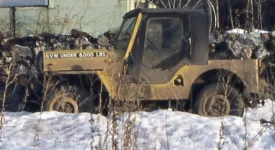
And it sort of managed to make an appearance in this scene.
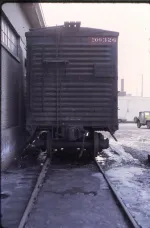
The tub had typical rust: the hat channels were gone as was most of the tool box enclosure and the tub mounts. I used it in that state for about a year and a half until I managed to burn the F head 2-3 exhaust valves trying to pull a tiny U-Haul trailer 650 miles. Enter version 2.0. At that point it was pushed off that proverbial modification cliff and a 1962 327 sbc found its way under that high hood, the rest of it remaining stock except for the original tires and wheels from my 68 CJ5 ,a patched up Whitco top from the same, and a swing-out rear tire/jerry can/ski rack carrier I built. The sbc was the 11:1 CR version with solid lifers, big heads, 302 Winters intake, Holley 650 cfm carb, and Hooker 9810 headers. As would be expected that left something to be desired in the rocks but it was an order of magnitude better than the F head. It was a pretty wild ride on the pavement with that engine the 5.38 gears. Only one photo survived of that version from 1974.
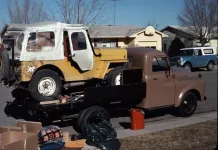
Alas, that 327 scummed to a crack in the rear side of the No 5 cylinder about a year and a half after the install, not an uncommon occurrence with those first year 4" blocks bored 0.030 over. At that point, the fall off that proverbial modification cliff much accelerated, perhaps not yet at terminal velocity but close. I did a frame off which became a little protracted with a job/state change in the middle of it. Changes with Ver 3.0 included a boxed frame, Con-Fer rear fuel tank, battery relocated beneath bed, new cross member under the radiator, 16:1 Saginaw steering box from a C3 Corvette, full float 19 spline Powr-Lok rear Dana 44 , 11" Bendix brakes, Muncie M20 Transmission , Warn Overdrive , 1970 350 LT1 engine (yep, slow learner), Chevy truck vertical style radiator, fiberglass tub and fenders, and a number of other changes. Initially it still sported the stock springs but those were swapped out for Rancho 2 1/2" lift springs almost as soon as those hit the market-remember this is still 1970's. I probably should have installed a NT Dana 30 at that point but those were still relatively new and expensive. The D25 persisted.
A few photos of Ver 3.0
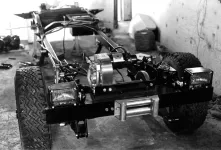
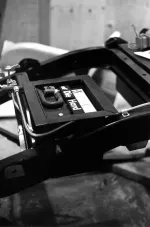
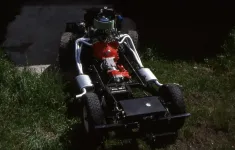
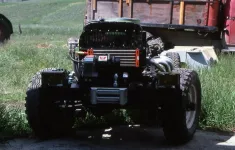
The glass tub was actually a 12'/foot plastic car kit. Separate pieces for the shell, floor and firewall and the only one I could find was for a 2A/3A so the cowl and firewall required that 4.5" extension and while I was assembling it, I made an inch and a half larger indent for distributor clearance.. I fabricated a subframe under the seat area to which the seat support frame bolted to and it provided sill support for the "sliders". The exhaust was also hung from that framework.
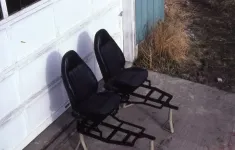
My original intent was to use an aftermarket steel hood, no doubt an early MD Juan product. It was painted with the rest of it, including the original grill, with catalyzed acrylic enamel but you can guess where that went. VERY poor fit and I couldn't use it.
This was the B at that point:
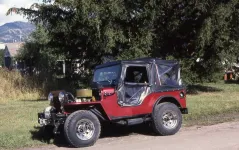
The LT1 was more than a wild ride with the remaining 5.38 gears and as one would expect, it didn't care too much about crawling over rock gardens. It was dumbed down with a set of 194 truck heads and a Performer cam not long after getting it back on the road but I had already started on a replacement-a 381 build using all GM parts (there weren't any 383 kits yet at that point). Along with the 381 swap, it received a Modine 3 row cross flow radiator and a number of other small changes, including a Saturday night special home brew hood consisting of an aluminum framework with a sheet fiberglass cover. The 381 proved to be just an excellent Jeep engine that would idle down to 300 rpms and still crawl over just about any obstacle without feathering the clutch.
The 381 era:

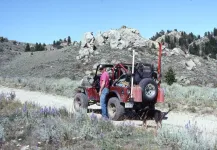
That version soldiered on for 3 1/2 decades with relatively minor further modifications. The 381 eventually got ProFlo2, aluminum heads, and a hydraulic roller cam.
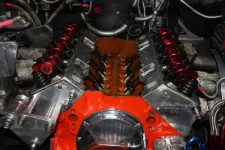

Along the way, the original D18 was replaced with a "super" D18 utilizing a Dana 20 case and the TeraLow 3.15:1 gear set, the drum brakes replaced with discs, the M20 replaced with an AutoGear M22W, and the Willys went on a bit of a diet. The skid protection was all replaced with aluminum versions, and an aluminum radiator installed. The hood was rebuilt and aluminum skinned. Added accessories included a York engine driven OBA set up and a Premier Power Welder.
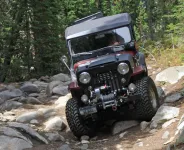
With that 4 1/2 decades down, we will get to the last iteration of this Willys, not a frame off, but maybe more severe.


